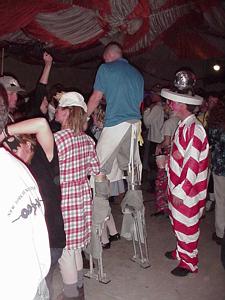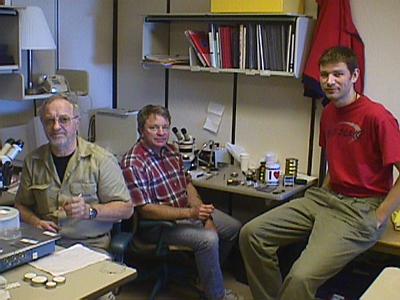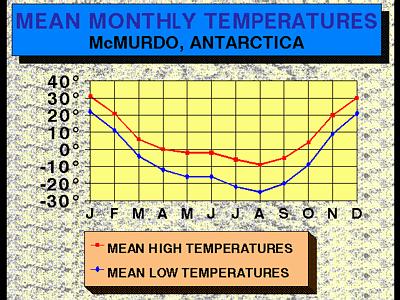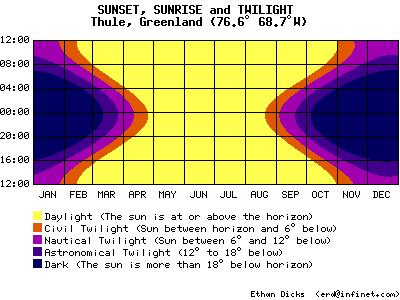4 November, 1999
I'm Baaaack. Yea, I know, I said I wasn't going to post a journal today.
Remember what I said about being flexible when traveling in Antarctica?
Well, I got all ready for the helo flight to Cape Roberts. Three other
people were scheduled to go with me. When we arrived, we checked in (they
weigh each person and their baggage) and then were told there was problem
with the larger helo (a door was broken) and they would have to take a
smaller helo. The smaller one had a cargo weight capacity of 750 pounds.
Well, since me, my baggage, and gear took up a third of that capacity, I was
left on the ground. Extreme bummer! Well, perhaps I will get a chance some
other time.
At least I get to finish my discussion about why Antarctica is so
cold. Did you find a city in the Northern Hemisphere which is just as far
from the North Pole as McMurdo is from the South Pole? If not, try Thule,
Greenland. But we will get back to that later.
Why is Antarctica so cold? Well, the obvious answer is the sun. Duh!
The angle of the sun is so low here that even when the sun is above the
horizon all day, like it is now, not much energy gets to the surface per
area unit. Add to this the increased depth of atmosphere that the sunlight
must penetrate and you can see why the sunlight that does reach here doesn't
provide much energy. Also, due to the bright white snow cover, much of the
sunlight that does fall on the surface is reflected back into space. Snow
has a high albedo. Albedo is a measure of the percentage of light a surface
reflects. A black surface has a low albedo. This is why cold weather
clothing is often a dark color to absorb energy more efficiently.
If this was all to the story, then Arctic temperatures would be the
same as the temperatures in the Antarctic because these same conditions
exist in the Arctic regions as well. There are two major factors that
contribute to the intense cold found in Antarctica. First, Antarctica is a
landmass. The Arctic region is primarily covered by ocean. The water of the
oceans retains energy better than a land surface. The ocean water can absorb
heat in the summer time and store it. This warmer water can then moderate
the temperatures in the winter months. This happens to a lesser degree in
Antarctic because of the huge landmass of the Antarctic Continent.
The oceans play an even more important role in the climate of
Antarctica. One way heat is moved around in the Earth system is by ocean
currents. Currents move heat absorbed by the waters near the Equator towards
the Polar Regions, north and south. Iceland, despite its name, has a fairly
mild climate for its latitude, because it is swept by relatively warm ocean
currents from the south. Warmer waters can move their way into the Arctic
Ocean moderating temperatures.
Antarctica has a totally different situation. About 34 million years
ago, when Australia and South America moved away from Antarctica, a strong
current developed which encircled the continent. The current, called the
Antarctic Circumpolar Current, essentially isolates the water around
Antarctica from the other oceans of the world preventing movement of warmer
water from the lower latitudes. This isolation has also contributed to the
unique types of animals found in the southern oceans.
Below is a chart of the monthly average high and low temperatures in
McMurdo. Also included are charts of sunlight for McMurdo and Thule,
Greenland. Compare the sunlight in the two locations. Are they similar?
(Remember that their seasons will be at opposite times of the year.) See if
you can find information on the annual temperatures for Thule. Is it warmer
in Thule than McMurdo? Check it out!
I forgot to tell you about the Halloween Party they had in McMurdo
last week. The costumes were great. Very creative. I have attached a picture
of the party. Everyone there seemed to be having a lot of fun!
There are a great number of interesting and talented people involved
in the Cape Roberts Project. Over the next several weeks, I want to
introduce you to some of the people from various counties who are
contributing to the success of the project. So here is today's CRP3 Featured
Team Members:
The group of micro-paleontologists who specialize in the study of marine
protists called foraminifera include Peter Webb from Ohio State University
in Columbus, Percy Strong from the Institute of Geological and Nuclear
Sciences in Lower Hutt, New Zealand and Wojciech Majewski. Wojciech is a
Ph.D. candidate at Ohio State and is from Warsaw, Poland. Peter Webb is also
the Senior Scientist for the Cape Roberts Project.

Halloween in Antarctica! think I found the South Pole. It isn't what I expected.

From left to right: Peter Webb, Percy Strong, and Wojciech Majewski.



Contact the TEA in the field at
.
If you cannot connect through your browser, copy the
TEA's e-mail address in the "To:" line of
your favorite e-mail package.
|
